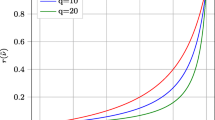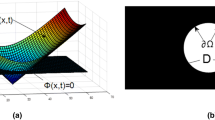Abstract
In the structural topology optimization (STO), the step-size of the parametric level set method (PLSM) using the explicit scheme must satisfy the Courant-Friedrichs-Lewy (CFL) condition to ensure numerical stability. However, much larger step-sizes are arbitrarily used to speed up the convergence. For this reason, a narrowband in the velocity field is defined, and the step-size adaptive parametric level set method (SAPLSM) is proposed, which multiplies different step-sizes for the velocity of different nodes. The SAPLSM satisfies the CFL condition not only on the narrowband, but also on the entire design domain. Furthermore, a narrowband annealing (NA) scheme based on “annealing” is proposed to dynamically adjust the maximum step-size during the iterations. Numerical experimental results of several benchmark problems in two-dimensional minimum compliance show that: (1) The SAPLSM is more stable than PLSM under large step-sizes and complex problems. (2) The NA scheme not only accelerates the convergence of SAPLSM but also alleviates mesh dependence.
Similar content being viewed by others
References
N. P. van Dijk, K. Maute and M. Langelaar, Level-set methods for structural topology optimization: a review, Structural and Multidisciplinary Optimization, 48(3) (2013) 437–472.
S. Mukherjee, D. Lu and B. Raghavan, Accelerating largescale topology optimization: state-of-the-art and challenges, Archives of Computational Methods in Engineering, 28(7) (2021) 1–23.
M. P. Bendsøe and N. Kikuchi, Generating optimal topologies in structural design using a homogenization method, Computer Methods in Applied Mechanics and Engineering, 71(2) (1988) 197–224.
M. P. Bendsøe, Optimal shape design as a material distribution problem, Structural optimization, 1(4) (1989) 193–202.
D. J. Munk, G. A. Vio and G. P. Steven, Topology and shape optimization methods using evolutionary algorithms: a review, Structural and Multidisciplinary Optimization, 52(3) (2015) 613–631.
L. Xia, Q. Xia and X. Huang, Bi-directional evolutionary structural optimization on advanced structures and materials: a comprehensive review, Archives of Computational Methods in Engineering, 25(2) (2018) 437–478.
J. A. Sethian and A. Wiegmann, Structural boundary design via level set and immersed interface methods, Journal of Computational Physics, 163(2) (2000) 489–528.
W. Khan, Siraj-ul-Islam and B. Ullah, Structural optimization based on meshless element free Galerkin and level set methods, Computer Methods in Applied Mechanics and Engineering, 344 (2019) 144–163.
T. Belytschko, S. P. Xiao and C. Parimi, Topology optimization with implicit functions and regularization, International Journal for Numerical Methods in Engineering, 57(8) (2003) 1177–1196.
M. Y. Wang, X. Wang and D. Guo, A level set method for structural topology optimization, Computer Methods in Applied Mechanics and Engineering, 192(1–2) (2003) 227–246.
J. Luo, Z. Luo and L. A. Chen, A semi-implicit level set method for structural shape and topology optimization, Journal of Computational Physics, 227(11) (2008) 5561–5581.
C. A. D. Moura and C. S. Kubrusly, The Courant-Friedrichs-Lewy (CFL) Condition 80 Years After Its Discovery, Birkhäuser, Boston, USA (2013).
A. L. Gain and G. Paulino, A critical comparative assessment of differential equation-driven methods for structural topology optimization, Structural and Multidisciplinary Optimization, 48(4) (2013) 685–710.
Z. Luo, M. Y. Wang and S. Wang, A level set-based parameterization method for structural shape and topology optimization, International Journal for Numerical Methods in Engineering, 76(1) (2008) 1–26.
P. Wei, Z. Li, X. Li and M. Y. Wang, An 88-line matlab code for the parameterized level set method based topology optimization using radial basis functions, Structural and Multidisciplinary Optimization, 58(2) (2018) 831–849.
B. Ullah, Siraj-ul-Islam and Z. Ullah, A parametrized level set based topology optimization method for analyzing thermal problems, Computers and Mathematics with Applications, 99 (2021) 99–112.
S. Y. Wang and M. Y. Wang, Radial basis functions and level set method for structural topology optimization, International Journal for Numerical Methods in Engineering, 65(12) (2006) 2060–2090.
M. Zhou and G. I. N. Rozvany, The coc algorithm, part ii: Topological, geometrical and generalized shape optimization, Computer Methods in Applied Mechanics and Engineering, 89(1–3) (1991) 309–336.
K. Svanberg, The method of moving asymptotes—a new method for structural optimization, International Journal for Numerical Methods in Engineering, 24(2) (1987) 359–373.
K. Svanberg, A class of globally convergent optimization methods based on conservative convex separable approximations, SIAM Journal on Optimization, 12(2) (2002) 555–573.
C. Zhuang, Z. Xiong and H. Ding, Topology optimization of transient nonlinear heat conduction using an adaptive parameterized level-set method, Engineering Optimization, 53(12) (2021) 2017–2039.
R. Malladi, J. A. Sethian and B. C. Vemuri, Evolutionary fronts for topology-independent shape modeling and recovery, European Conference on Computer Vision, Stockholm, Sweden (1994) 1–13.
J. A. Sethian, Level Set Methods and Fast Marching Methods: Evolving Interfaces in Computational Geometry Fluid Mechanics, Computer Vision, and Materials Science, Cambridge University Press, New York, USA (1999).
R. Tsai and S. Osher, Level set methods and their applications in image science, Communications in Mathematical Sciences, 1(4) (2003) 623–656.
H. Wendland, Piecewise polynomial, positive definite and compactly supported radial functions of minimal degree, Advances in Computational Mathematics, 4(1) (1995) 389–396.
C. Zhuang, Z. Xiong and H. Ding, A level set method for topology optimization of heat conduction problem under multiple load cases, Computer Methods in Applied Mechanics and Engineering, 196(4–6) (2007) 1074–1084.
N. Metropolis, A. W. Rosenbluth, M. N. Rosenbluth, A. H. Teller and E. Teller, Equation of state calculation by fast computing machines, The Journal of Chemical Physics, 21(6) (1953) 1087–1092.
S. Kirkpatrick, C. D. Gelatt Jr and M. P. Vecchi, Optimization by simulated annealing, Science, 220(4598) (1983) 671–680.
G. Rozenberg, T. Bäck and J. N. Kok, Handbook of Natural Computing, Springer, Berlin, Heidelberg, Germany (2012).
P. J. M. van Laarhoven and E. H. L. Aarts, Simulated annealing, Simulated Annealing: Theory with Applications, Springer, Dordrecht, Holland (1987).
Siraj-ul-Islam, W. Khan and B. Ullah, The localized radial basis functions for parameterized level set based structural optimization, Engineering Analysis with Boundary Elements, 113 (2020) 296–305.
B. Ullah, J. Trevelyanb and Siraj-ul-Islam, A boundary element and level set based bi-directional evolutionary structural optimisation with a volume constraint, Engineering Analysis with Boundary Elements, 80 (2017) 152–161.
Acknowledgments
The first author would like to acknowledge the equipment support sponsored by the Big Data Laboratory of Xi’an Aeronautical Institute.
Author information
Authors and Affiliations
Corresponding author
Additional information
Chen-Dong Yang is currently a doctoral student of the School of Science, Chang’an University, Xi’an, China, and a lecturer of the School of Science, Aeronautical Institute, Xi’an, China. His research interests include optimum structural design and mathematical optimization.
Jian-Hu Feng is a Professor of the School of Science, Chang’an University, Xi’an, China. He received his Ph.D. in Aero Engine from Northwestern Polytechnical University Xi’an, China. His research interests include optimum structural design, computational fluid dynamics and high-performance computing technology for scientific and engineering problems.
Ya-Dong Shen is a lecturer in the School of Civil and Architectural Engineering, Nanyang Normal University, Nanyang, China. He received Ph.D. in School of Science, Chang’an University, Xi’an, China. His research interests include optimum structural design and foundation treatment.
Rights and permissions
About this article
Cite this article
Yang, CD., Feng, JH. & Shen, YD. Step-size adaptive parametric level set method for structural topology optimization. J Mech Sci Technol 36, 5153–5164 (2022). https://doi.org/10.1007/s12206-022-0928-6
Received:
Revised:
Accepted:
Published:
Issue Date:
DOI: https://doi.org/10.1007/s12206-022-0928-6




